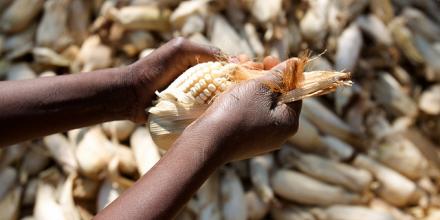The following story, by IFPRI Director General Shenggen Fan, was originally published on the Development Policy Centre’s blog. The piece is based on Shenggen’s keynote address at the Crawford Fund’s Annual Parliamentary Conference on Ethics, Efficiency and Food Security.
Hunger and malnutrition are big global challenges that confront humanity. Nearly 850 million people across the globe are hungry. More than 2 billion people suffer from deficiencies in essential vitamins and minerals, and about the same number of people are overweight and obese.
The development of Sustainable Development Goals (SDGs) to anchor the post-2015 development agenda is now well underway. Elimination of extreme poverty is at the center of the effort, but the agenda needs to give more attention to the elimination of hunger and malnutrition.
Elimination of hunger and malnutrition should be equally central because poverty, hunger and malnutrition are linked in a vicious cycle. Hunger and malnutrition affect the capability of individuals to escape poverty by reducing their capacity for physical activity and impairing physical and cognitive development.
Hunger and malnutrition impose huge social and economic costs, which can be felt at individual, household and societal levels. International Food Policy Research Institute (IFPRI) research shows that growth failure in early childhood is likely passed to the next generation. Productivity losses and direct healthcare costs caused by hunger and malnutrition also have adverse economy-wide effects. For example, hunger and undernutrition cost the global economy USD $1.4 to $2.1 trillion per year—the equivalent of 2 to 3 percent of global GDP, according to the Food and Agriculture Organization of the United Nations. As a result of being overweight or obese, the World Health Organization estimates that about 3.4 million adults die each year, accounting for 3.9 percent of years of life lost.
The good news is that investments in eliminating hunger and malnutrition have high economic benefits. For instance, in India, research shows that every dollar spent on interventions to reduce stunting is estimated to generate about USD $34 in economic returns.
Global development actors, including governments, development agencies, civil society, philanthropy organizations and the private sector, play a critical role in ensuring food security and nutrition. However, inefficient policies and practices that add to the burden of hunger and malnutrition—underinvestment in food security and nutrition; lack of social safety nets to protect the poorest; unsustainable use of natural resources in food production; trade restrictions; and gender inequality in agriculture—must be eliminated.
Over the years, a number of global and national commitments have been made to advance global food security and nutrition, but gross underinvestment in agriculture and nutrition persists. The emerging complexity of global development challenges requires increased and prioritized investments in food security and nutrition that take into account emerging trends. To achieve substantial improvement in nutrition, investments in both nutrition-specific and nutrition-sensitive interventions are needed. Nutrition-specific interventions, such as micronutrient supplementation and adolescent health and pre-conception nutrition, help to address the immediate causes of under-nutrition. Nutrition-sensitive interventions, such as agriculture and food security programs and social safety nets, address the underlying causes of under-nutrition.
Well-targeted, productive and cross-sectoral social safety nets are still under provided in many developing and emerging countries. These safety nets are needed as short-term cushions for poor people in the face of livelihood shocks and also for long-term productivity-enhancing or exit opportunities for smallholders, for example. IFPRI research demonstrates that combining income transfers with a provision of agricultural services, such as extension, is more beneficial to smallholders than stand-alone programs.
Another source of inefficiency is unsustainable natural resource use for food production. Inefficient agricultural subsidies in many developed and developing countries promote overuse of natural resources and increase carbon emissions. Re-prioritization of limited resources towards high-return investments is needed to increase efficiency and eliminate hunger and malnutrition. However, the removal of such subsidies may cause food prices to increase with negative implications for poor producers and consumers. In this case, strong social safety nets have a key role to play.
Investments in agricultural technologies that produce more with less are also crucial. Resource-efficient agricultural technologies and practices, such as no-till farming, nitrogen-use efficiency, precision agriculture and drip irrigation help to get more nutrients with more efficient use of all inputs and natural resources.
Distortionary trade policies, such as export bans, lead to food price hikes and volatility, which hurt the poor and hinder the efficiency of agricultural markets. Avoiding such harmful policies to facilitate open, transparent and fair global trade promotes efficient allocation of resources and improves access to food.
Gender inequality also leads to inefficient allocation of resources. This, in turn, means reduced agricultural productivity and poor nutrition and health outcomes. Support for gender equality in agriculture, such as increased land rights, contributes to higher agricultural output in developing countries, as well as improved nutrition and health for women and children, as research demonstrates.
Concerted action to eliminate hunger and malnutrition calls for efficient policies and practices from all stakeholders. It is good economics and also the right thing to do.







